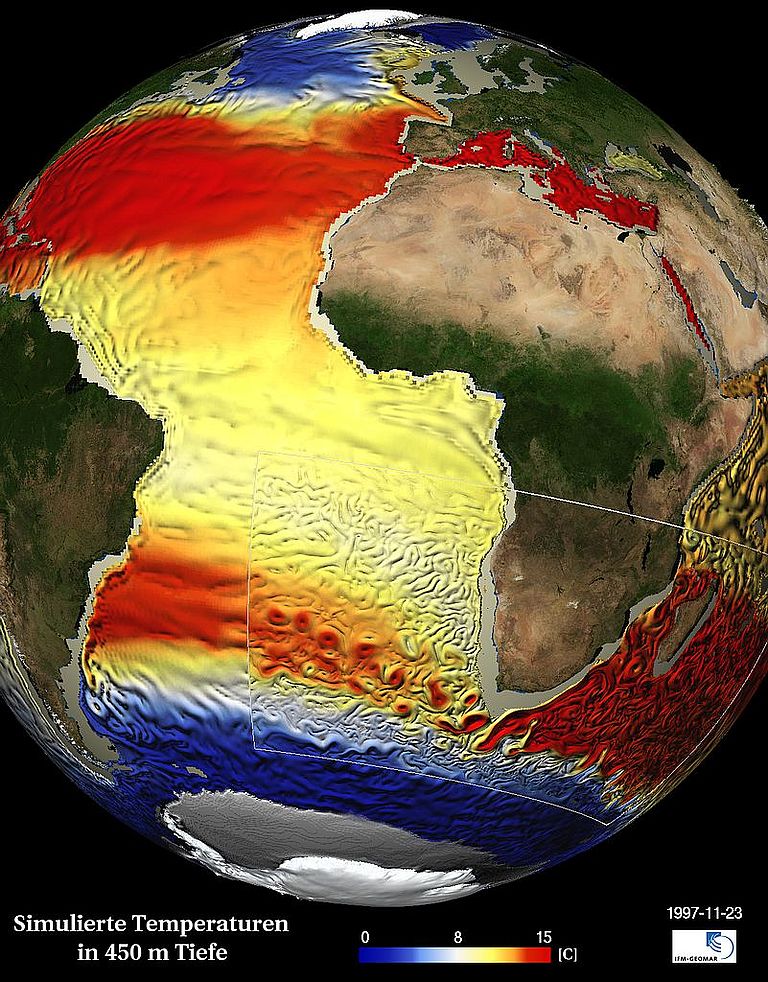Live saver for the Gulf Stream?
November 25, 2009, Kiel. The Gulf Stream system is known for its impact on Europe’s mild climate. For quite some time oceanographers and climate scientists worry that its strength could decline due to the climate change. Unexpected help could come from the ocean currents south of Africa: researchers of the Leibniz Institute of Marine Sciences (IFM-GEOMAR) and the University of Cape Town have discovered that the Agulhas Current transports more saline waters into the Atlantic. These could potentially contribute to stabilize the Gulf Stream system. The study will appear on 26 November in the world-renowned scientific journals Nature.
The Agulhas Current, like the Gulf Stream one of the strongest currents in the world ocean, flows in the Indian Ocean along the South African coast. Southwest of Cape Town it abruptly turns back into the Indian Ocean. In this process huge rings of water with diameters of hundreds of kilometres are cut off at intervals of 3 to 4 months. (see Fig. 1). These so-called “Agulhas Rings” carry warm and saline waters from the Indian Ocean into the Atlantic.
„It sounds strange that the currents around South Africa suppose to have an influence on our climate“ says Dr. Arne Biastoch from the Leibniz Institute of Marine Sciences (IFM-GEOMAR) in Kiel, first author of the research paper. “But it is known for quite some time that the Agulhas region is one of the key regions for the supply of salty waters into the Atlantic”, Arne Biastoch continues. “By analyzing observational data and computers models we have shown that this process is strengthening due to the climate change in the Southern Ocean,” adds co-author Prof. Dr. Claus Böning from IFM-GEOMAR. What is the reason? Naturally, westerly winds in the Southern Ocean are blocking the water exchange between the Indian Ocean and the Atlantic. In the past decades, a southward shift of these westerlies has widened the corridor south of Africa for the inflow of water into the Atlantic. This trend could further intensify in the future as part of climate change.
In the Atlantic this extra amount of salty water is transported northward by the prevailing currents and could finally help to stabilize the Gulf Stream system in the northern North Atlantic. There it could act against the freshening process due to enhanced precipitation and the ice melting. Nevertheless, additional computer simulations are required to proof the hypothesis whether or not changes by the Agulhas Current have the potential to neutralize the freshening in the North Atlantic These do require detailed models which need to simulate fine structures of the ocean currents. Even with the most advanced generation of supercomputers at Kiel University and the national high performance computing centres in Berlin, Hamburg or Stuttgart, integrations of just a few decades require several months.
Original publication:
Biastoch, A., C.W. Böning, F.U. Schwarzkopf und J.R.E. Lutjeharms, 2009: Increase in Agulhas leakage due to poleward shift of Southern Hemisphere westerlies. Nature, 462 (7272), doi:10.1038/nature08519.
Contact:
Dr. Andreas Villwock (public relations), Phone: +49 / 431 600 2802, avillwock@geomar.de



